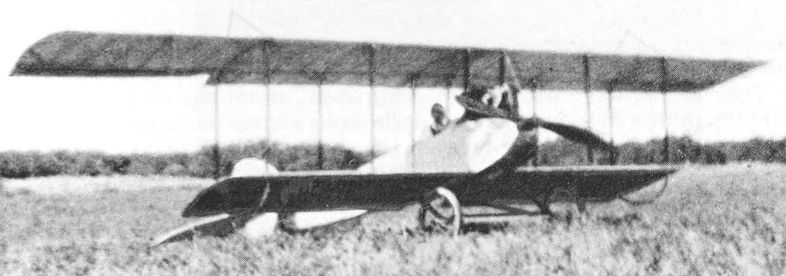K.Molson, H.Taylor Canadian Aircraft since 1909 (Putnam)
Partridge-Kent Biplane
Frederick Kent was born in 1886 in Killarney, Manitoba, a small town about 50 miles south of Brandon and near the United States border. By 1910 he owned a bakery shop in the town. He developed an interest in aviation, read current aviation periodicals, and built aircraft models, at least one of them being displayed in his shop. He then decided he wanted to learn how to build an aircraft and went to the United States early in the winter of 1914-15. He is believed to have taken brief flying lessons but not soloed. Almost certainly, he must have been at Cicero Field, Chicago. then a well-known aviation centre, for he returned home with drawings for the Partridge biplane which was built there by Elmer Partridge and Henry Keller. (A number of similar Partridge-Keller biplanes were built at Cicero Field from 1913 to 1917. The best known of these was the Gnome-powered Partridge-Keller Looper which was flown extensively on exhibitions in 1916 in the USA, Canada, and Japan, by Katherine Stinson)
Kent immediately started on construction of his aircraft and was assisted by a 15-year-old boy, Wilfred W. Schnarr, from whom all information on Kent’s work has emanated. The aircraft was a single-seat, unequal-span biplane, and the overhang was braced by wires from kingposts and the front spar served also as the leading edge. For flight control a wheel was mounted on the control column and its rotation controlled the rudder, and Schnarr recalls that forward motion of the column caused the aircraft to climb while side-to-side motion controlled the ailerons in the usual way. The throttle was operated by a foot pedal and was normally held wide open by a spring and closed by depressing the pedal. The engine was a four-cylinder water-cooled unit fitted with a Bosche magneto and, almost certainly, of American origin and developing 50/60 hp.
Components were made in a shed behind Kent’s store and the aircraft assembled in a vacant lot across from the store. It was towed by a horse to a field he was allowed to use, about a mile and a half south of the town, and stored, hidden from view, in a grove of poplar trees. It was here in the summer of 1915 that he began taxi-ing trials of his aircraft and to learn how to fly it. He made hops only a foot or two off the ground and during the course of the trials suffered two slight accidents, one when he ran into a pothole, and another when a wheel, lacking a cotter-pin, came off. Repairs were needed on both occasions. At the time of the last accident the owner of the field reclaimed it for autumn ploughing and trials were terminated.
The next year, 1916, Kent moved to a field east of the town and there made his first real flights, at 5 to 10 feet off the ground. The water-cooled engine seemed to have ample power but it was suspected that the cooling was not satisfactory; nevertheless one evening he took off on his first flight beyond the field boundaries which he crossed at 200-300 ft (60-90 m). However, the water boiled and blew in his face. He attempted a turn, his first, but had to land in a nearby pasture, damaging the aircraft. The owner of the field then said he would have to stop using it as he was scaring the horses.
In 1917 Kent attempted to use the local fair-ground but it was small and unsuitable, and it is doubtful whether any flights were made.
In the early spring of 1918 the aircraft was taken to the ice on a nearby lake. On starting, the engine suffered damage, apparently through lack of oil, and this appears to have been the last time it was taken out. Its fate is unknown.
Dimensions, weights and performance are not known.


